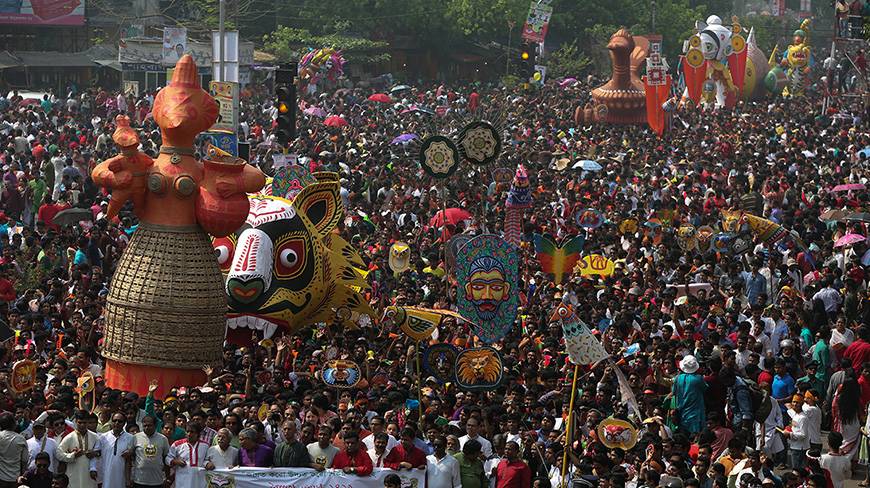The nation is celebrating Pahela Baishakh, the country’s biggest and most colourful festival marking the first day of the Bangla New Year – 1421.
Tens of thousands of people from all walks of life joined celebrations on Monday to welcome the day with new hopes in a spirit of communal harmony.
Thousands were out on the streets, in parks, and in open spaces since morning on a joyous New Year’s Day, casting aside the past year’s gloom caused by relentless political turmoil.
People thronged the various places of popular and historical interest in capital Dhaka and elsewhere, savouring a very special public holiday.
Pahela Baishakh is celebrated by all communities with enthusiasm and excitement, made especially attractive by cultural programmes held all through the day.
Places in Dhaka such as Ramna Park, Suhrawardy Udyan, Central Shaheed Minar, Dhaka University, Shahbagh, and Dhanmondi Lake areas attracted thousands, in a mood to celebrate.
The most colourful event was at the Ramna Batamul, where Chhayanaut, a leading cultural troupe, staged an enthralling programme as dawn broke.
Chhayanaut artistes, assembled beneath a banyan tree, welcomed the day with Rabindranath Tagore’s famous song ‘Esho hey Baishakh, esho, esho’ at the Ramna Park.
The area saw a surge of human tide well before Chhayanat’s programme began at 6am.
At the outset, noted cultural personality and Chhayanat President Sanjida Khatun appealed for communal harmony and social bonhomie nurtured for thousands of years.
“Our aim is to have bright serenity all around us. And this can be done by upholding communal harmony,” the Tagore aficionado said.
She claimed religious zealots were bringing in money from abroad and spending a bit of it to engage a section of people to spread subversion.
“It’s not our responsibility to ensure proper education. But it’s our duty to make people realise that violence isn’t the real tenet of religion. We’ve to spread that awareness through songs, poems, dramas etc,” she said.
The Pahela Baishakh function commenced with Raag Ahir Bhairav, played by eminent sarod artiste Rajrupa Chowdhury, spreading through the crisp morning air.
There was tight security at Ramna Batamul to prevent any militant strike.
In 2001, the Bangla New Year celebrations there had come under a bomb attack, prompting enhanced security measures.
People had to pass though several check points to reach the traditional venue but no one grudged the extra precaution.
Chhayanat has been holding the morning music session of the Pahela Baishakh celebrations at Ramna Batamul since 1967.
It had been initiated by the well-known Tagore music exponent, Wahidul Haque, and Sanjida Khatun.
Later, Udichi Shilpighoshthi and other cultural organisations joined in.
Chhayanat was founded in 1961 to mark the birth centenary of Rabindranath Tagore defy a ban imposed by the then Pakistani regime on the singing of Tagore songs.
With the Chhayanat programme ending a little before 9am, the crowd shifted to the Dhaka University campus.
There, students of the Institute of Fine Arts took out a ‘Mangal Shobhajatra’ – a pageant within a carnival wishing the nation well with festoons, replicas of animals, and other traditional symbols.
Celebration of Pahela Baishakh has become an integral part of Bengali culture since it began being observed over six centuries ago.
Mughal Emperor Akbar had introduced the Bengali calendar in the year 1556 of the Gregorian calendar to streamline the collection of land tax in the then ‘Subah Bangla’, much of it now in Bangladesh.
A highlight of Pahela Baishakh is to open the ‘halkhata’ (a new book of accounts) – again, a tradition since the time of Akbar.
Initially, it was strictly a financial affair but now it has become an inseparable feature of the Baishakhi celebrations.
Traders and businessmen of all communities close their old books of accounts and open new ones. They invite customers, sharing sweets as a mark of goodwill and renew business deals.
Source: Bd news24

